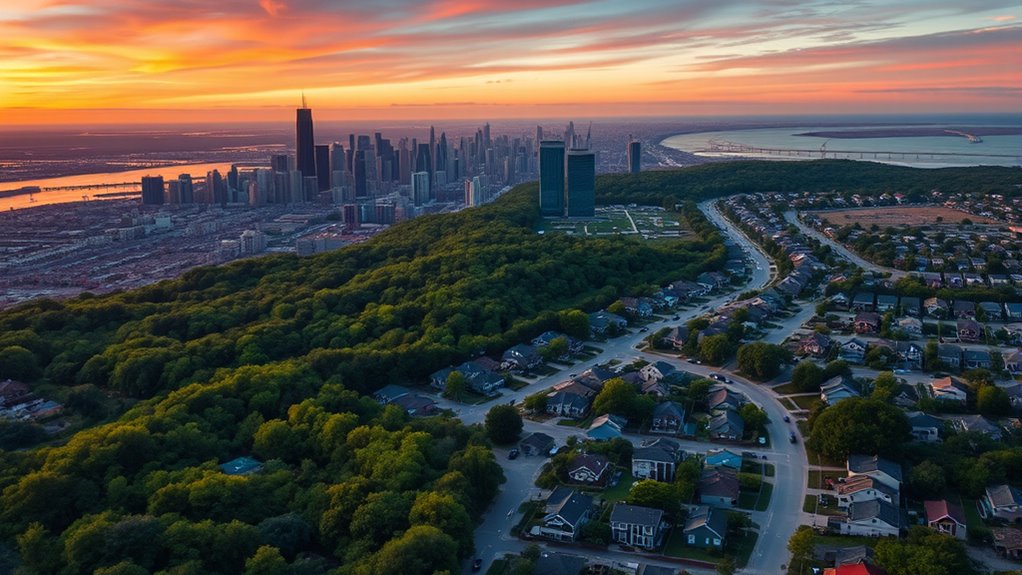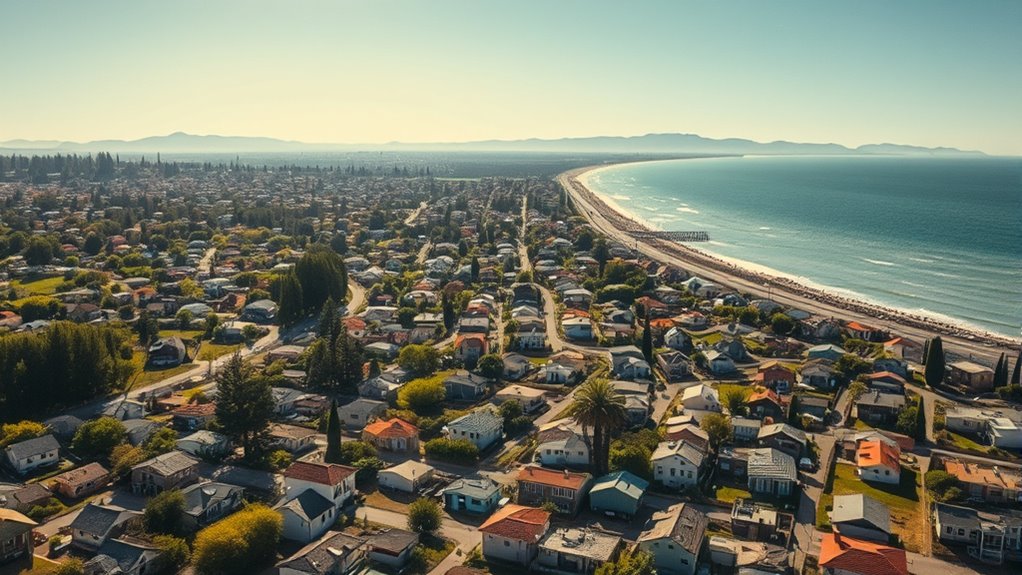Climate migration is reshaping the U.S. housing map as more people move inland to escape rising sea levels, flooding, and storm risks along coastlines. States like Colorado, Texas, and Midwest areas see an influx of residents seeking safer, more resilient communities. Coastal regions investing in resilience efforts might hold their populations, but those without such measures risk decline. To understand how these shifts are changing where people live and why, keep exploring the latest trends.
Key Takeaways
- Coastal cities face depopulation due to rising sea levels and increased flooding risks, prompting residents to relocate inland.
- Inland regions like Colorado and Texas are experiencing population growth as climate migration shifts demand away from vulnerable coastlines.
- Urban resilience investments, including flood defenses and sustainable infrastructure, attract residents to safer, climate-adaptive communities.
- Real estate development focuses on constructing climate-resistant buildings in low-risk areas, reshaping housing markets nationwide.
- Community planning and AI modeling help identify vulnerable zones and guide migration patterns, influencing the future U.S. housing landscape.

Have you ever wondered how rising climate threats are shaping where people choose to live in the United States? As climate change accelerates, so do concerns about rising sea levels, which threaten coastal communities and push residents inland. Coastal cities like Miami, New Orleans, and parts of New York face increasing risks of flooding and storm surges, making them less attractive for long-term living. This shift isn’t just about immediate weather events; it’s about ongoing vulnerability. Many residents and prospective homeowners are now reevaluating their options, seeking safer, more resilient places to settle. Cities that invest in urban resilience—strengthening infrastructure, flood defenses, and emergency preparedness—become more appealing. These efforts help communities adapt to climate impacts, but they also influence migration patterns, as people weigh the safety and stability of their surroundings.
As rising sea levels threaten to reshape coastlines, some individuals are choosing to relocate to inland areas that offer better protection against climate risks. This migration isn’t random; it’s driven by the desire for safer neighborhoods, economic stability, and quality of life. States like Colorado, Texas, and parts of the Midwest are seeing an uptick in new residents, drawn by affordability and lower exposure to climate hazards. Meanwhile, coastal regions that fail to build resilience may experience depopulation, as residents move away to escape the threat of flooding and erosion. Urban resilience becomes a key factor in this dynamic, as cities that prioritize sustainable infrastructure and climate adaptation can retain their populations longer, even as climate threats grow. Incorporating aesthetic wall organization systems and other resilient design features can enhance community safety and visual appeal. Additionally, investing in climate-resilient infrastructure is crucial for safeguarding future growth. Moreover, the role of community engagement is vital in fostering local support for resilience initiatives and ensuring that adaptation efforts meet residents’ needs. Utilizing AI-powered modeling can assist city planners in predicting vulnerable areas and optimizing resilience strategies. Understanding the importance of climate adaptation strategies helps communities better prepare for inevitable changes.
The shifting housing map reflects these realities. Developers are increasingly investing in climate-resistant buildings and infrastructure in safer zones. Governments are also offering incentives for relocating away from high-risk areas, encouraging people to consider new, less vulnerable locations. This transition isn’t just about avoiding climate disasters; it’s about creating communities that can withstand future shocks. As people move away from vulnerable coastlines, the landscape of American cities and towns is transforming. New economic hubs may emerge inland, while some traditional coastal areas face decline. The importance of urban resilience becomes clear: it’s not just about surviving climate change but thriving despite it. Your choices about where to live are now deeply intertwined with these broader trends, shaping the future of U.S. housing in a changing climate.
Frequently Asked Questions
How Will Climate Migration Affect Future U.S. Infrastructure Planning?
Climate migration will considerably influence future U.S. infrastructure planning by emphasizing urban resilience and infrastructure modernization. You’ll need to focus on strengthening flood defenses, updating transportation systems, and ensuring utilities can handle population shifts. As people move to less vulnerable areas, planning must adapt to new demands, making cities more resilient against climate impacts. This proactive approach helps safeguard communities, supports sustainable growth, and prepares infrastructure for ongoing climate challenges.
What Policies Are in Place to Support Climate Migrants?
You should know that climate refugee policies are evolving to support those displaced by climate change. Some states and local governments offer relocation incentives to encourage climate migrants to settle in safer areas. However, federal policies are limited, and ongoing efforts aim to improve assistance and integration programs. By understanding these policies, you can see how they help mitigate displacement impacts and promote resilient community planning.
How Does Climate Migration Impact Local Economies?
They say change is the only constant, and climate migration proves this. As people move to new areas, you see local economies experience both challenges and opportunities. Increased diversity can boost innovation, supporting community revitalization. However, rapid influxes can strain resources, impacting economic resilience. You play a crucial role in helping your community adapt, ensuring growth and stability amid these shifts, turning climate migration into a catalyst for positive change.
Are There Specific Vulnerable Regions More Prone to Climate Displacement?
You’ll notice that vulnerable regions, especially coastal areas and low-lying communities, are more prone to climate displacement. These displacement hotspots face increased risks from rising sea levels, hurricanes, and flooding. As climate change accelerates, these regions become even more susceptible, prompting residents to leave their homes. Recognizing these vulnerable regions helps you understand where climate migration is likely to intensify, reshaping communities and infrastructure across the country.
What Role Do Real Estate Developers Play in Climate Migration Adaptation?
You can see that real estate developers play a pivotal role in climate migration adaptation by focusing on urban resilience and green development. They design and build communities that withstand climate impacts, promoting sustainable infrastructure and eco-friendly housing. By prioritizing resilient, green projects, developers help cities better absorb climate shocks and support displaced populations, ensuring long-term stability and healthier environments amid changing migration patterns.
Conclusion
Like the winds shifting in a storm, climate migration redraws your map of the U.S., reshaping communities and futures alike. As history whispers through the changing landscape, you’re called to understand that this movement isn’t just about homes, but about resilience and adaptation. Just as rivers carve new paths, your awareness can guide you through these shifts, reminding you that in every upheaval, there’s an opportunity to build anew—stronger, smarter, together.
Amina brings over a decade of journalism experience to her role as Editor-in-Chief. Under her leadership, Exquisite Post has flourished, maintaining the highest standards of integrity and excellence. Amina’s commitment to truth and her visionary approach guide the editorial team in producing impactful news stories that resonate with our audience.










